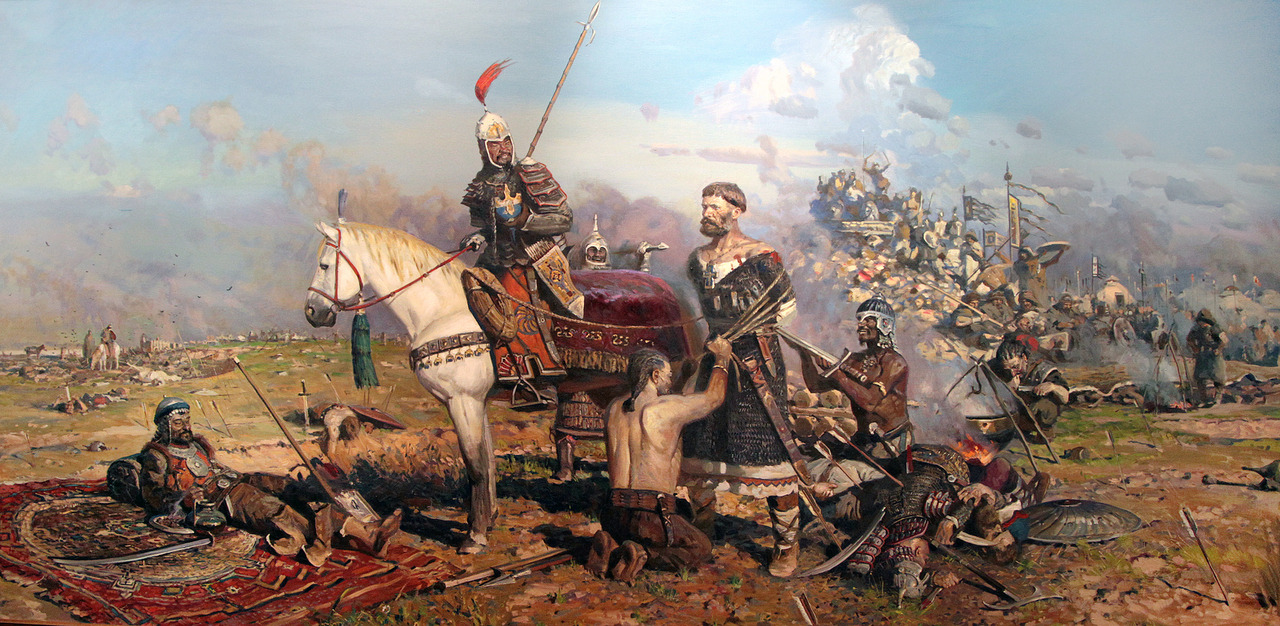The Mongol Empire, which emerged as the dominant power on the steppe, launched three major military campaigns over a period of approximately forty years, from 1219 to 1260.
Genghis Khan, who razed the capital of the flourishing Khwarezm Empire in just three days across Iran, Afghanistan, and Uzbekistan, gave 30,000 troops to his most capable generals, Jebe and Subotai, to conquer the west. The reason was ostensibly to pursue the fleeing Sultan Muhammad al-Ala ad-Din of Khwarezm, but it was also to scout and conquer the European world. After several minor skirmishes in Persia, the two generals reached the southern region of Russia.
Then in May 1223, eight Russian principalities united and led a massive army of 80,000 troops to march southward. The forces of generals Jebe and Subotai numbered only 20,000, a quarter of the enemy’s size. The Russian coalition forces were fully armed knights clad in armor and helmets.
The tactic used by the Mongolian army was the same as always, a feigned retreat. They engaged the Russian army, then, as if exhausted, began to retreat, fleeing at any sign of capture, evading for a whole week. When the invaders repeatedly retreated, the Russian army began to pursue. The formation of the Russian army started to elongate, and both soldiers and horses became exhausted. Finally, when the Mongolian army reached the Kalka River, they suddenly stopped, then all switched to fresh horses and began to form up for battle.
At the forefront of the attack were the mounted archers of the heavy cavalry. As they shot their arrows in unison, they swirled through the stretched-out Russian ranks, causing chaos in the Russian lines in the blink of an eye. As they were thrown into disarray, the heavy cavalry disappeared, replaced instantaneously by heavily armed medium cavalry. Unlike the lightly armed mounted archers, the medium cavalry wore chainmail and breastplates, carrying battle axes and two bows. They wielded long spears, up to 3.6 meters long, as if playing with toys, freely thrusting them about. As the vanguard of the Russian army crumbled, the momentarily vanished mounted archers reappeared and showered arrows upon the Russian main force like rain.

The result was devastating. Mongol archers, riding well-trained horses and boasting accuracy, ravaged the Russian camp. The Russian army began to flee, and the pursuing Mongol mounted troops began the slaughter of the fleeing soldiers. As the sun set and darkness fell, the Mongol pursuit finally ceased. In just one day of battle, the 80,000-strong Russian army was completely annihilated, with most of the soldiers killed. This was the Battle of the Kalka River, which spread terror across Europe of the Mongol onslaught.
Like other conquerors, Genghis Khan and his descendants harbored ambitions of world conquest and had confidence in their abilities for it. In the case of the Mongol Empire, their capability lay in their highly mobile invincible cavalry.
However, the Mongolian army didn’t consist solely of cavalry. Within their cavalry units, heavily armored medium cavalry and lightly armored mounted archers cooperated in combat missions. The mounted archers, generally lightly armed, used the mobility of their horses and bows to protect the charges of the medium cavalry and devastate enemy positions. Even when they collaborated, they didn’t attack the dense main formation of the enemy infantry head-on but employed tactics to attack the flanks or weak points. Mounted archers mainly armed with bows would engage enemy archers and infantry to disorient the enemy line. Conversely, when weaknesses were exposed, the heavily armored medium cavalry would advance to decide the battle.
In human society, there are no autocratic leaders. Even in animal societies, upon closer observation, principles of cooperation, collaboration, and coexistence can be found. While competition for food and mating partners is a reality, it’s not the sole focus. A closer look at the animal world reveals that there are more relationships based on mutual assistance. Small animals form herds to appear larger and more threatening, thus reducing the chances of being preyed upon. Hyenas, although smaller and weaker than lions, maintain a balance of power through greater numbers and cohesion, despite their smaller size.
Sometimes successful individuals may become arrogant and boast about their success, but the truth is, around every successful person, there are always people who have helped them. This kind of unseen assistance could come from someone who has been observing my efforts without my knowledge. Thinking that there’s nothing one can accomplish alone is the best approach. Having good collaborators puts a person in a much stronger position in competition.
That’s why companies don’t hesitate to form alliances, even with competitors. Let’s recall the discussions about the laws of increasing returns and the Lancaster law, which argue that competitiveness can be secured through positive feedback.
In reality, it’s rare for a single company to provide a product or service from start to finish. For individuals with limited capacity for work and variety, this goes without saying. As mentioned, most products are made up of a complex network. Finding a product that succeeds alone is even more challenging in today’s digital economy. If everyone within the value chain, from consumers to suppliers, doesn’t cooperate, everyone within that value chain can lose their competitiveness simultaneously.
Today’s business competition isn’t about individual versus individual or company versus company. It’s a world war where networks fight for survival against other networks. Companies that failed to realize this form of inter-corporate competition struggled, while those who realized it and actively embraced it achieved unprecedented growth.
Creating their networks within the market is what companies are doing. However, these networks aren’t their own league. Those leading the way create unexpected new connections to secure competitiveness.
Apple is a company that manufactures computers. However, they developed their software for the computers they made. Their hardware was superior, but their graphic operating system was very innovative, a leading software product. However, Apple prevented other companies from accessing the Macintosh system. They believed they could monopolize the market through their technological competitive advantage. However, that market accounted for only 8% of the entire personal computer market.

In contrast, IBM allowed the production of computers imitating their own computers and called these computers ‘IBM Compatible.’ All computers compatible with IBM’s computers were called IBM Compatible, and these computers were produced not only in the United States but also in Korea and Taiwan. Now the computer war had become a battle between ‘just PC’ and ‘Apple’s Mac.’
In this war, Bill Gates’ Microsoft gained the upper hand. Microsoft started as a simple supplier of operating systems to IBM. They were just part of IBM’s network, yet they ended up with 92% of the ‘just PC’ operating system market. While IBM thought of hardware and software separately, and Apple thought of them as one product, their profits went to Microsoft. Of course, this was because IBM underestimated the size of the PC market, and Apple overestimated their competitive advantage.
While the outcomes for individual companies varied depending on their strategic moves, they learned a lesson that markets created through collaboration between companies could be much larger than independently created markets. Indeed, companies are now more interested in cooperation than competition, using strategic alliances as essential means of corporate strategy. Considering the flood of alliances that seems absurd and random to some extent, it seems that alliances are no longer just an option but a necessary requirement for companies desiring sustainable growth and innovation.
There have always been partnerships between companies in the past. However, those partnerships were passive mergers to expand or defend power. In contrast, today’s partnerships are more active and proactive. Intentions to create new markets go beyond merely wanting to expand the market. Nike’s collaboration with Apple to introduce ‘Nike Plus’ could be a good example. By partnering with Apple, Nike not only allowed runners to enjoy music with iPods while wearing Nike sneakers but also measured the calories, time, distance, pace, etc., of their workouts. They created a new market by working together.


답글 남기기